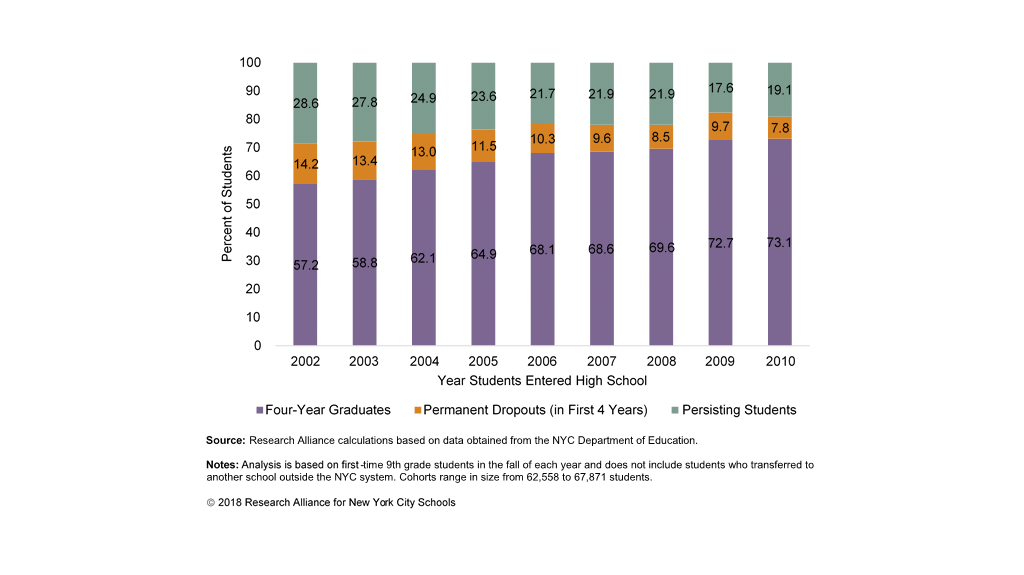There is much to celebrate in New York City’s rising high school graduation rate—over the past decade, the percentage of students who earn their diploma in four years has steadily increased, and rates of college enrollment have largely kept pace. The related decline in high school dropout rates has also received a good deal of attention here in the City and around the country.
However, as we argue in our new brief, this binary focus—on students who either graduate on time or drop out of school entirely—misses an important group of students: those who do not complete high school in four years but remain enrolled (or reenroll) and continue making a good faith effort to earn their diploma (sometimes after temporarily dropping out). We describe this group as “persisting students.”
We decided to focus on persisting students because they currently constitute more than two thirds of the young people who do not graduate on time in New York City. Put differently, persisting students are a significantly larger group than those who drop out in four years and don’t return to school. And while there is solid base of research about students who drop out, less is known about those who stay enrolled in high school for more than four years. Understanding the trajectories of persisting students can help policymakers and educators develop more effective strategies for both prevention (i.e., identifying students early and getting them back on track to graduate in four years) and intervention (i.e., providing supports that help students succeed after they have fallen behind).
In this post we ask: How has the likelihood of becoming a persisting student changed over time in New York City? The figure below shows the percentage of students in each cohort of first-time 9th graders, between 2002 and 2010, who graduated on time, dropped out by the end of their fourth year of high school, and who persisted into their fifth or sixth year.[1]
Percentage of 9th Graders Who Graduate On-Time, Permanently Drop Out Within Four Years, or "Persist" in High School, 2002-2010

- On-time graduates consist of students who earn a high school diploma[2] by the end of their fourth year of high school. As the purple sections of the bar graph show, the proportion of four-year graduates has grown tremendously, from 57 percent of students who started high school in 2002 to 73 percent of those who started in 2010.
- Students who drop out of high school by the end of their fourth year and do not return to school at any point during the next two years are categorized here as permanent dropouts. As the graph indicates, the share of students permanently leaving the system has declined, from 14 percent for the entering freshman class of 2002 to 8 percent among those who entered in 2010.
- Persisting students include all young people who did not earn their high school diploma within four years but remained actively enrolled in school for at least one semester during their fifth or sixth years of high school. They are represented by green sections in the graph and, although their proportions have declined since 2002, they still represent a significant share of students: Almost a fifth (19 percent) of first-time freshmen in 2010 went on to become persisting students.
As one might imagine, persisting students are not only a large group (numbering over 12,000 among the 2010 9th grade cohort), they are also a vulnerable population. As our brief describes, drawing on interviews with persisting students and further analyses of administrative data, persisting students have dealt with an array of challenges that have limited their capacity to graduate from high school on time. The brief examines students’ experiences and pathways through the system, the supports they found helpful, and their eventual outcomes—tackling some (but not all) of the big questions outlined below.
Big Questions
- What are the characteristics of persisting students, and which high schools do they attend? Are certain types of students more or less likely to become persisters?
- What happens to persisting students? How many of them are able to eventually earn a high school credential and go on to college? And how long does it take them to succeed?
- What systems are in place to identify and support persisting students? How effective are these systems?
- How have persisting students been affected by changing high school graduation requirements during the time period represented in the graph above?
What else should we be asking about persisting students? Let us know via email.
This post was authored by Zitsi Mirakhur and Kathryn Hill.
Footnotes
[1]We count students who graduated in the summer after their fourth year of high school as on-time graduates. For this reason, student status “at the end of their fourth year of high school” is in fact measured as of October in the following school year.
[2]Here we classify students who earn a Regent or local diploma as high school graduates.
How to Cite this Spotlight
Mirakhur, Z., Hill, K. 2018. "How Have the Rates at Which Students Are Graduating in Four Years, Dropping Out, or "Persisting" in NYC High Schools Changed Over Time?" Spotlight on NYC Schools. Research Alliance for New York City Schools.

